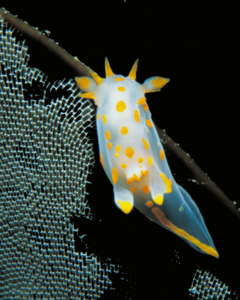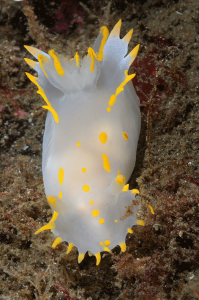Polycera quadrilineata and Polycera faeroensis
We have recently got requests to present some our posts in english, so we start of with this post about our species of Polycera.
During fieldwork at Hitra in October this year we observed an enormous abundance of one of our most common nudibranch species, Polycera quadrilineata. Even though this nudibranch is a common sight, we must not forget Polycera faeroensis, a similar species with only a handful of observations along the Norwegian coast.
Polycera quadrilineata (Müller, 1776) and Polycera faeroensis Lemche, 1929, are two representatives of a small family of nudibranchs called Polyceridae, which comprises the genera Colga, Limacia, Palio and Polycera in norwegian waters. Within this family only Limacia clavigera and P. quadrilineata can be considered to occur commonly here in Norway (north to Lofotoen). Colga is a little known genus that has been found from Spitsbergen and the Barents Sea south to Bodø along the norwegian coast. Palio is represented with two species of which one can be considered rare.

The basis for the family Polyceridae is Polycera quadrilineata which in 1776 was described by Otto Friedrich Müller from the Drøbak Sound. This species reaches a length of 40 mm, and is characteristic with its translucent white body with yellow appendages. Firstly, note the 4-6 oral tentacles around the mouth in front of the rhinophores. Secondly, note the yellow blotches scattered around the dorsal side of the body and the yellow broad stripe that completes the tail from the gill bush. Sometimes the yellow blotches melt together forming several continuous stripes integrated with black stripes (zebra-stripes). The species epithet “quadrilineata” given by Müller is based on such pigmented individuals. Our observations of P. quadrilineata from central Norwegian localities indicate that zebra-stripes individuals are rather rare. However, from the west coast of Sweden, Anita Tullrot wrote a PhD dissertation investigating any possible molecular differences between normally pigmented and zebra-striped individuals of P. quadrilineata, but could not find species-specific differences.
In 1929, the Danish malacologist Henning Lemche, found individuals of Polycera from the Faroe Islands which did not fit the morphological variations in Polycera quadrilineata, and described Polycera faeroensis. This species differs in external morphology from P. quadrilineata in the number of oral tentacles and the frequency of yellow blotches – P. faeroensis normally has 8-12 oral tentacles while P. quadrilineata has 4-6, and the yellow blotches on the dorsal side of the body seem to be absent in P. faeroensis.

For a long time Polycera faeroensis was only known from the Faroe Islands and the west coast of Sweden, but has in recent times also been found around the British Isles. Here in norwegian waters it was missing until 2004, when we finally found this species from Bud at the coast of Møre and Romsdal after being informed by Nils Aukan who had taken very good photos of it. In our search of this species we also found specimens previously not published in the scientific collections at the NTNU Museum of Natural History and Archaeology here in Trondheim identified by Henning Lemche himself, which showed a distribution from Hjeltefjorden near Bergen to the Trondheim fjord.
Both species feed on bryozoans like Membranipora and Electra, and Polycera quadrilineata is one of the most common species of nudibranchs you can find in our kelp forests. We assume that P. faeroensis can be found in the same habitat as P. quadrilineata, but Nils Aukan has informed us that his observations of this species are usually a bit deeper than where he observes P. quadrilineata.
Tags In
Kategorier
- Arrangement (3)
- feltarbeid (35)
- fieldwork (2)
- Gulen (5)
- In English (2)
- Info (5)
- Litteratur (2)
- Nakensnegler i media (4)
- Nye funn (28)
- Presentasjon av arter (41)
- Prosjekter (6)
- Ukategorisert (4)
Siste innlegg
- Gammelt navn til en nakensnegl ny for Norge 30. august 2023
- Two new Dendronotus species from Norway 5. april 2023
- To nye arter Dendronotus fra Norge 4. april 2023
- Dendronotus frondosus – trillingen som ingen klarer å artsbestemme 29. mars 2023
- Nå har artene skiftet navn igjen 22. januar 2023
- Idaliadoris depressa – en ny navneendring hos onchidoridiidene 6. januar 2023

